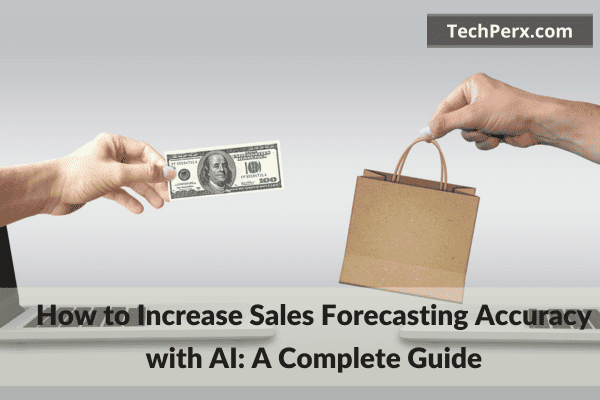Accurate sales forecasting is crucial for business success, allowing organizations to make informed decisions and boost profitability. Traditional forecasting methods often fall short, but Artificial Intelligence (AI) has transformed the game. In this comprehensive guide, we’ll explore how US businesses can implement AI to improve sales forecasting accuracy and gain a competitive edge.
Table of Contents
Understanding AI in Sales Forecasting
What is AI in Sales Forecasting?
Artificial Intelligence (AI) in sales forecasting refers to the use of advanced technologies that enable machines to learn from data, identify patterns, and make predictions. It involves utilizing algorithms and models that can analyze vast amounts of historical sales data, customer behavior, market trends, and other relevant factors to generate accurate forecasts.
Benefits of AI in Sales Forecasting
The implementation of AI in sales forecasting offers several significant benefits for businesses in the USA. One of the primary advantages is enhanced accuracy. AI algorithms can identify complex patterns and relationships within sales data, leading to more precise predictions. This accuracy empowers businesses to make data-driven decisions, allocate resources effectively, and optimize inventory levels.
Furthermore, AI-driven sales forecasting improves efficiency by automating manual forecasting processes. It saves time and allows sales teams to focus on strategic tasks rather than spending hours crunching numbers. AI also provides valuable insights into market trends, customer behavior, and demand patterns, enabling businesses to respond proactively and adjust their strategies accordingly.
Also Read: Power of Artificial Intelligence in Payroll Processing
Preparing for AI Implementation in Sales Forecasting
Assessing Data Quality and Availability
Before implementing AI in sales forecasting, it’s essential to assess the quality and availability of data. High-quality and comprehensive data is crucial for accurate predictions. Businesses should evaluate their existing data sources, identify any gaps or inconsistencies, and establish processes for data collection, cleansing, and integration.
Identifying Key Metrics and Variables
To improve forecasting accuracy, it’s vital to identify the key metrics and variables that have the most significant impact on sales. AI algorithms can analyze various factors, including historical sales data, customer demographics, market trends, promotional activities, and external factors like economic indicators. By understanding these variables, businesses can prioritize and fine-tune their forecasting models.
Establishing Data Governance and Privacy Measures
Implementing AI requires careful attention to data governance and privacy. As businesses handle sensitive customer data, it’s crucial to establish robust data governance practices and ensure compliance with regulations like the General Data Protection Regulation (GDPR). This includes implementing secure data storage, defining access controls, and prioritizing data security and privacy.
Selecting and Implementing AI Tools and Technologies
Choosing the Right AI Solutions
When selecting AI solutions for sales forecasting, businesses should consider several factors. Scalability is crucial to accommodate the growing data volumes and future business needs. Integration capabilities ensure seamless integration with existing systems and workflows. User-friendliness enables easy adoption and usage across teams. Additionally, reliability and vendor reputation should be evaluated through thorough research, customer reviews, and engaging with vendors through demos and trials.
Implementing AI Models and Algorithms
Once the appropriate AI solution is selected, the next step is implementing AI models and algorithms for sales forecasting. This involves training the AI models using historical sales data. Popular algorithms used in sales forecasting include regression analysis, neural networks, decision trees, and ensemble methods. These algorithms can identify patterns, correlations, and nonlinear relationships within the data, leading to more accurate predictions.
Integrating AI into Existing Sales Processes
To maximize the benefits of AI-driven sales forecasting, it’s crucial to seamlessly integrate AI into existing sales processes. Collaboration between the AI system and sales teams is essential. AI can provide valuable insights, but it’s the human expertise and domain knowledge that can contextualize and apply those insights effectively. Sales professionals should work closely with AI systems to interpret the generated forecasts, understand contextual nuances, and make informed decisions based on the combined intelligence of AI and human expertise.
Monitoring, Refining, and Adapting AI-Driven Sales Forecasts
Continuous Performance Evaluation
Once AI-driven sales forecasting is implemented, continuous performance evaluation is necessary to ensure accuracy. This involves regularly assessing the forecasts against actual sales data and measuring forecasting errors. Metrics such as mean absolute percentage error (MAPE) and root mean square error (RMSE) can be used to evaluate the accuracy of the forecasts. Continuous monitoring enables businesses to identify potential issues and refine their forecasting models accordingly.
Iterative Refinement and Model Adaptation
Business dynamics and market conditions change over time, requiring AI models to adapt and evolve. By incorporating new data, refining algorithms, and continuously training the models, organizations can ensure that their forecasts remain accurate and aligned with the evolving landscape. Iterative refinement and model adaptation are crucial to maintain the relevance and effectiveness of AI-driven sales forecasting.
Human Expertise and Collaborative Decision-Making
While AI is a powerful tool for sales forecasting, it should complement human expertise rather than replace it. Sales professionals play a vital role in interpreting the AI-generated forecasts, understanding contextual nuances, and making informed decisions. By fostering collaboration between AI systems and human experts, businesses can leverage the strengths of both to achieve more accurate forecasts and improved decision-making.
Conclusion:
Implementing AI to increase sales forecasting accuracy is no longer a luxury but a necessity for businesses in the USA. By understanding the basics of AI in sales forecasting, preparing data, selecting appropriate tools, and monitoring performance, organizations can unlock the full potential of AI-driven insights. Embracing AI as a strategic ally empowers businesses to make data-driven decisions, optimize resources, and drive growth in the dynamic marketplace. Start your journey towards accurate sales forecasting today and stay ahead of the competition with the power of AI.
Definitely, an exceptional person while writing and creating content. Harry Rasmussen is someone with a scintillating personality. He has done his management studies and proudly came into the writing field. He creates fabulous consistency with detailing in his writing that anyone loves to read it.

